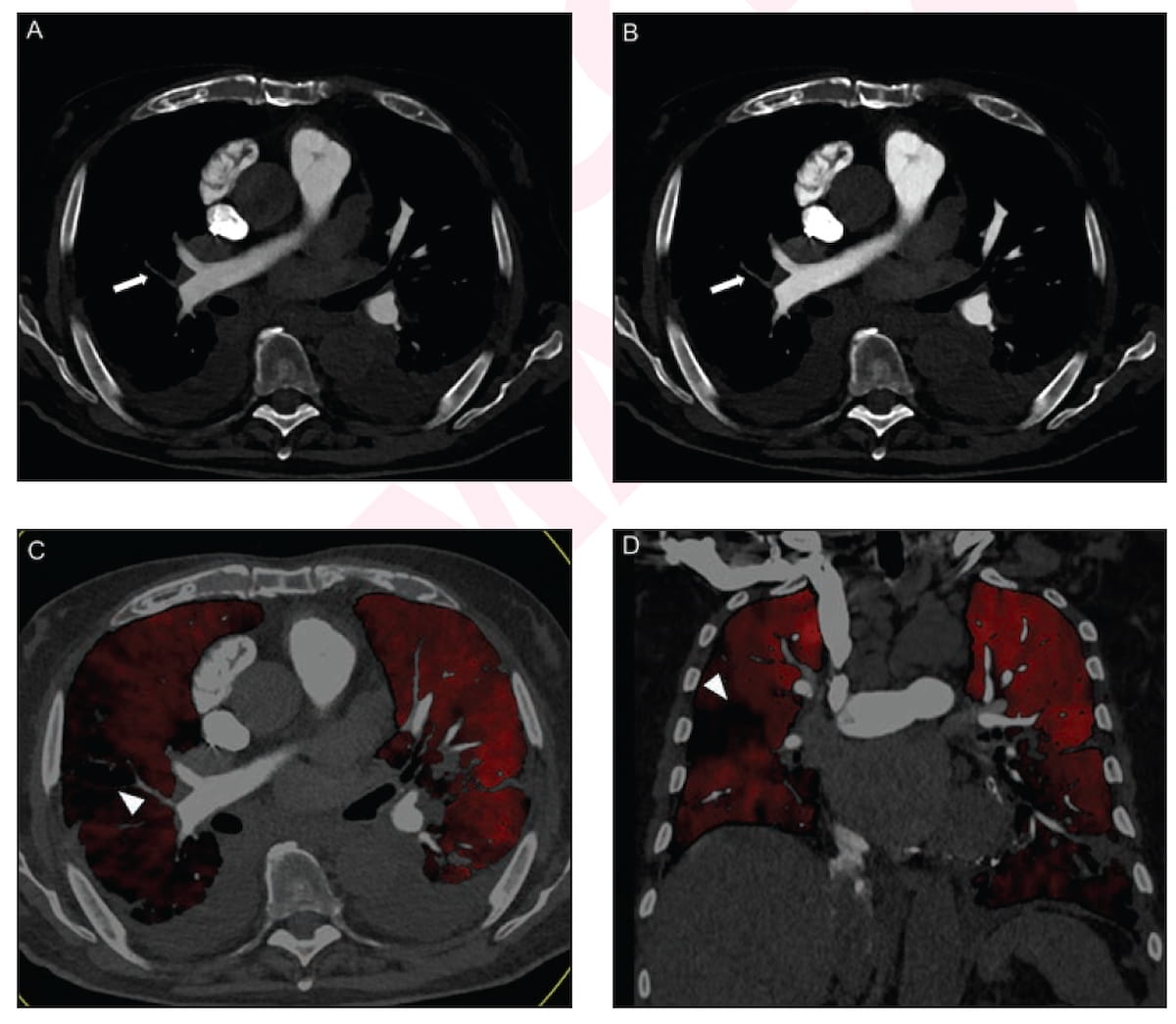Emerging research suggests the use of photon counting technology offers significant improvements in image quality at lower radiation dosing than energy-integrating detection (EID) for computed tomography pulmonary angiography (CTPA) exams.
For the prospective study, recently published in the American Journal of Roentgenology, researchers compared image quality between 58 patients who had high-pitch photon counting detector (PCD) CTPA and 59 patients who had dual-energy EID CTPA. Reviewing radiologists examined 120-kV polychromatic images, 60-keV virtual monogenetic images (VMI) and iodine maps for all patients in the cohort (mean age of 65), according to the study.
Other than the left upper lobe artery, the study authors found that PCD CTPA had a significantly higher signal-to-noise ratio (SNR) and contrast-to-noise ratio (CNR) in comparison to EID CTPA. For 120-kV polychromatic images of the right lower lobe artery, PCD CTPA had a SNR of 34.5 and CNR of 29.2 whereas EID CTPA had a SNR of 28 and a CNR of 24.4. For 60-kV VMI images of the right lower lobe, the researchers found that PCD CTPA demonstrated a 43.2 SNR in contrast to 32.7 for EID CTPA and a CNR of 37.4 in comparison to EID CTPA.
Noting a pitch of 0.55 for EID CTPA and 2.0 for PCD CTPA in the study, the researchers said the capability of utilizing high-pitch settings is a significant advantage for PCD CTPA over dual-energy EID CTPA.
“This higher pitch for PCD CTPA leads to a shorter acquisition time, in turn possibly reducing the susceptibility to pulsation or respiratory artifacts. This reduction in artifacts likely acts in combination with the higher CNR and SNR of PCD CTPA to yield the technique’s observed higher subjective image quality. The more rapid acquisition for PCD CTPA may be particularly advantageous in patients with pulmonary embolism, who commonly present with tachycardia and dyspnea,” wrote lead study author Pauline Pannenbecker, M.D., who is affiliated with the Department of Diagnostic and Interventional Radiology at University Hospital Wurzburg in Germany, and colleagues.
Three Key Takeaways
- Improved image quality with photon counting technology. The study suggests that photon counting technology, specifically high-pitch photon counting detector (PCD) for computed tomography pulmonary angiography (CTPA) exams, provides significantly higher signal-to-noise ratio (SNR) and contrast-to-noise ratio (CNR) compared to traditional dual-energy energy-integrating detection (EID) methods. This improvement in image quality can aid in better diagnostic accuracy and interpretation.
- Reduced radiation dosing. Photon counting CTPA was found to have lower radiation dosing compared to EID CTPA. The study reports lower CT dose index volume (CTDIvol), effective dose, and dose length product (DLP) for PCD CTPA. This reduction in radiation exposure is important for patient safety and aligns with the principles of optimizing medical imaging to minimize potential harm.
- Advantages in imaging obese patients. The use of photon counting technology, with an expanded spectral field of view (FOV), is highlighted as advantageous for imaging obese patients. The larger FOV with PCD CT may contribute to improved image quality in larger patients, particularly due to the use of a single voltage for both x-ray tubes, reducing susceptibility to artifacts commonly associated with dual-energy EID CTPA methods.
The study authors also pointed out lower radiation dosing for PCD CTPA in contrast to EID CTPA, noting lower CT dose index volume (CTDIvol) of 3.9 mGy vs. 5.5 mGy, a lower effective dose (2.2 mSv vs. 2.8 mSv, and a reduced dose length product (DLP) of 123.5 mGy*cm vs. 157 mGy*cm.
For the imaging of obese patients, the study authors said an expanded spectral field of view (FOV) with PCD CT (50 cm) offers another advantage over EID CT with a spectral FOV of 35.3 cm.
“Use of PCD CT for CTPA may improve image quality in large patients given the use of the same voltage for both x-ray tubes (120 kVp in this study) in contrast with distinct tube potentials for dual-energy EID CTPA (90 kV and Sn150 kV in this study). The use of a single voltage for PCD CTPA may lessen susceptibility to artifacts from photon starvation … ,” added Pannenbecker and colleagues.
(Editor’s note: For related content, see “Current Concepts with Advances in Photon-Counting Computed Tomography,” “Emerging Concepts with ICM Reduction and Photon Counting for Coronary CT Angiography” and “Study Says Photon-Counting CT Offers Better Lung Assessment than Conventional CT.”)
Beyond the inherent limitations of a single-center study, the authors acknowledged a small sample size and the lack of an independent reference standard for confirming that additional pulmonary emboli detected on iodine maps are true positives. The researchers conceded they did not assess the location and extent of pulmonary emboli. They also noted that anatomic image maps and iodine maps were not assessed in separate sessions.
